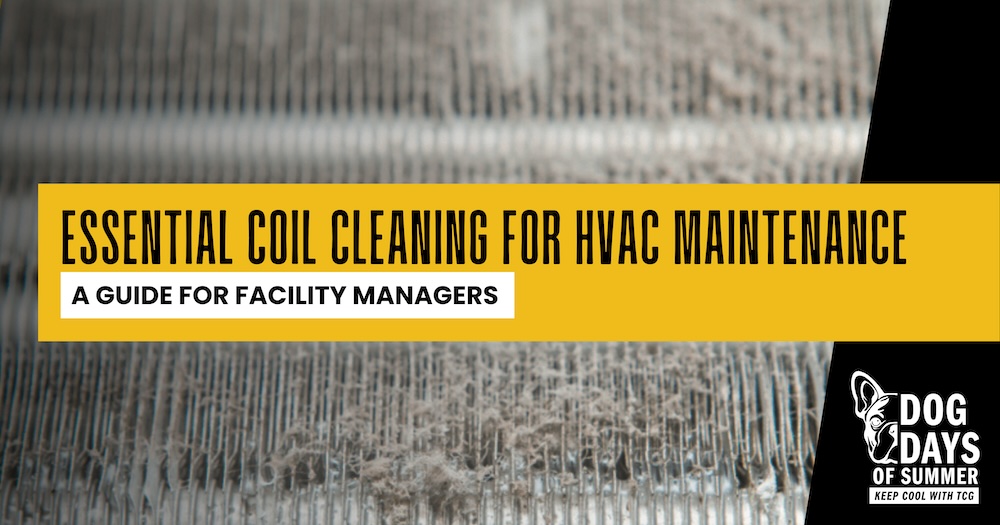
Essential Coil Cleaning for HVAC Maintenance: A Guide for Facility Managers
Maintaining an efficient HVAC system is one of the top priorities for facility managers and property owners.
One essential yet often overlooked aspect of this maintenance is regular coil cleaning. Why? The coils in an HVAC system play a critical role in heat exchange, and their cleanliness directly impacts the system’s efficiency and longevity, as well as the facility’s indoor air quality.
Before we discuss why coil cleaning should be an essential part of facility managers’ routine preventative HVAC maintenance plan, let’s discuss coils a little further.
HVAC Coils: Types and Importance
HVAC systems typically contain two types of coils: evaporator coils and condenser coils. Evaporator coils absorb heat from indoor air, while condenser coils release that heat outside.
Both coils are essential for the refrigeration cycle which enables the HVAC system to regulate indoor temperatures effectively and provide overall comfort.
Not sure what to look for when it comes to coil health? If your HVAC system:
- Turns on and off frequently;
- The air coming from the vents is warm;
- There is a refrigerant leak near the indoor cooling system components;
- You hear unusual noises coming from the cooling system;
There is a good chance one or both types of coils are bad.
To avoid any of these unwanted scenarios, the Total Comfort Group team is here to highlight the benefits of tracking coil health and functionality so that facility managers can avoid downtime, save on repair costs, and lower energy consumption.
Ditch the Dirty Coils
Over time, a system’s evaporator and condenser coils accumulate dirt, dust, and debris. This buildup can significantly hinder performance, resulting in a variety of unwanted issues for facility managers, including reduced efficiency and increased wear and tear on the overall system.
Thankfully, regular coil cleaning, which involves special equipment and techniques to remove dirt, debris, and other contaminants, can prevent high costs, high energy consumption, and subpar comfort and air quality. This helps facility managers focus on operational efficiency rather than reactive repairs and maintenance.
Five Reasons to Regularly Clean Coils
By making the effort to schedule and track coil cleaning, facility managers can experience the following benefits:
- Enhanced efficiency: Clean coils mean better heat exchange, allowing the HVAC system to operate more efficiently and maintain consistent indoor temperatures without unnecessary strain.
- Lower operational costs: Improved efficiency means reduced energy consumption and lower utility bills. Over time, this can offer substantial savings.
- Improved indoor air quality: Regularly cleaned coils reduce the risk of mold and bacteria build-up. A healthier indoor environment reduces the risk of respiratory issues among building occupants and, dependent on industry, helps meet indoor air quality standards.
- Extended equipment life: Maintaining clean coils helps prevent excessive wear and tear. By regularly cleaning coils, facility managers extend the life of their systems and postpone the need for emergency replacement parts and major repairs.
- Environmental benefits: Less energy consumption is a positive overall. An efficient HVAC system consumes less energy and reduces a facility’s carbon footprint, supporting overarching ESG goals.
How to Establish a Coil Cleaning Routine
So far, we’ve addressed the role coils play in an HVAC system, how dirt, dust, and debris inhibit function, and why coil cleaning is so important. Now, let’s get to the most important piece of the puzzle: establishing a coil cleaning routine.
The first step in cleaning coils is conducting regular inspections of the HVAC system to identify dirty coils early. The frequency may vary depending on the building’s location and environment. Here at TCG, we recommend quarterly maintenance as a good starting point including an annual coil cleaning.
Next, we recommend you hire professional HVAC technicians who have the experience and equipment to do the job right and use the appropriate techniques, tools, and cleaning agents to avoid damage to the system. For example, finned coils, also known as heat transfer coils, might need a fin comb to straighten and clean between the fins.
We mentioned ditching the dirty coils above, but it isn’t always just coils. Clean air filters help ensure the area around the unit is clear of debris.
Lastly, it’s important to document all maintenance activities, including coil cleaning, to help track service history and plan for future cleanings.
Final Thoughts
The benefits of clean coils far outweigh the effort and cost associated with replacement parts and HVAC system repairs. When coil cleaning is made a priority, an HVAC system operates optimally, and facility managers can promote comfortable, healthy environments for occupants.
By implementing a consistent coil cleaning schedule and working with professional commercial HVAC service providers, facility managers and property owners can safeguard their investments, enhance total comfort, and reduce their carbon footprint.
Do you have questions about a coil cleaning schedule for your facilities, or are you looking for a service provider? Total Comfort Group is a multi-solution, self-performing provider of commercial HVAC/R, plumbing, and electrical services throughout 50 percent of the U.S. and professionally manages coverage nationwide. Contact us today!



